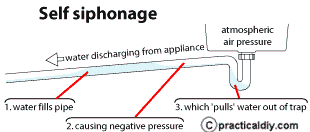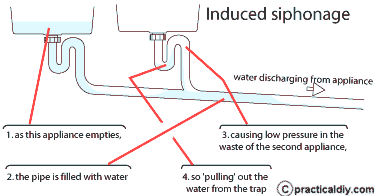Noises from the plumbing
Various different noises come from plumbing systems as the water flows through the pipes.
Such noises are usually initially annoying but people quickly become used to them and tend to put up with them.
However such noises sometimes indicate a problem and/or can be easily reduced so the reason for any noise should be investigated.
This article explains some typical noises from the plumbing and, where possible, suggests actions to cure them.
If plumbing is correctly installed in the first place, most of the noises wouldn't occur.
Typical noises include:
- one or two loud banging noises, usually when a tap is closed
- a series of rapid banging noises
- shushing noise as water flows through the pipes
- splashing noises as a cistern or tank refills
- gurgling through the pipes
- gurgling from a waste trap
- noise generated by a pump
- creaking floorboards
One or two loud banging noises, usually when a tap is closed
This is a typical water hammer sound caused by a loose jumper or washer in a valve. See our article specifically dealing with ‘water hammer’.
A series of rapid banging noises
Another typical water hammer sound but this time caused by a float valve not closing smoothly. See our article specifically dealing with ‘water hammer’.
Shushing noise as water flows through the pipes
There are two probably causes for this sort of noise:
- The small burrs were not removed from inside the copper pipes after being cut using a tube cutter.
- Pipes running within a timber stud wall. The plaster boarded studwork acts as a resonator, and the sound of the water flowing through the pipe is amplified. When installing pipes within stud walls, the pipes should, where possible, be insulated from the framework by mounting the pipe clips on rubber or felt pads – this should stop or reduce the transmission of the noise.
Curing these installation problems after the work has been completed is very difficult.
Turning down the stopcock to reduce the water flow in the pipes may reduce or possibly cure the noise. Where pipes are part of a central heating system, reducing the pump pressure may have a similar effect.
Splashing noise as a cistern or tank refills
This is just the noise of the water coming out of the valve under pressure.
Fitting a Torbeck valve (which incorporates a polythene collapsible tube to feed the incoming water below the water level) will significantly reduce the noise. These are normally fitted to WC cisterns but can also be fitted to cold water storage tanks. Alternatively, insulating cold water storage tanks will significantly reduce the noise; however the noise could still be a nuisance if the tank were, say, installed in, or directly above, a bedroom but fitting a Torbeck valve will reduce the noise.
Gurgling through the pipes
Some gurgling noises through the pipes can be expected in a new plumbing system, or one which has been drained and refilled, as the air trapped inside rises through the system. Gurgling noises associated with central heating pipes probably indicates that the radiators will need bleeding to release air trapped in them.
If gurgling sounds continue to flow up through the pipes, it indicates a greater problem. Air could be being drawn into the system, possibly by an incorrectly positioned pump in a heating. When air is continually drawn into a system, the rate of corrosion within it will increase, it is therefore important that the problem is identified and rectified as soon as possible so that the life of the system is not reduced.
Gurgling from a waste trap
Gurgling noises from a waste trap usually indicate that the water seal is being siphoned out of the trap. The gurgling sound is the air being pulled through the trap as the result of low pressure created in the waste pipes.
The siphon action can be one of two types - both types are usually encountered in long runs of relatively small diameter waste pipe where the waste water fills the cross-section of the pipe as it flows along forming a ‘plug’ of water:
 Self-siphonage – is where the ‘plug’ of water flowing along the pipe forms a vacuum behind it sucking the water out of the trap.
Self-siphonage – is where the ‘plug’ of water flowing along the pipe forms a vacuum behind it sucking the water out of the trap. Induced siphonage – this occurs where two waste traps feed into a common waste pipe. When waste water is discharged into the pipe from one trap, as that water flows down the pipe, the air is drawn through the other trap.
Induced siphonage – this occurs where two waste traps feed into a common waste pipe. When waste water is discharged into the pipe from one trap, as that water flows down the pipe, the air is drawn through the other trap.
Both these forms of siphonage are really design faults; if larger diameter waste pipe had been used or additional venting included, the discharge of the waste water would not create the siphon action.
Noise generated by a pump
On a central heating system, reducing the pump pressure should reduce or possibly reduce the problem. However, this could cause another problem in large heating systems – the radiators furthest from the pump may not heat up, this would require the radiators to be rebalanced.
On a shower pump, check that the pipes to the pump have been connected using flexible connections and also that the pump is mounted on flexible mounting. Also check that the pump is not touching anything which could act as a resonator and so amplify the noise.
Creaking floorboards
Creaking floorboards are usually caused by hot water pipe expanding and contracting under the floorboards and moving where they pass through the floor joists where the notches are only just large enough, or where adjacent pipes under the floor are touching one another.
When copper pipes are laid in notches cut into the joists, they should be laid on a piece of carpet felt underlay or similar; this will reduce the noise of the pipes moving.
Where plumbing pipes are laid adjacent to one another, care should be taken that they cannot touch or rub against one another.
